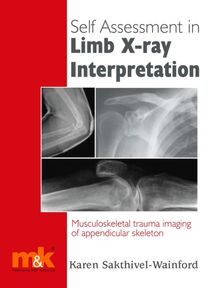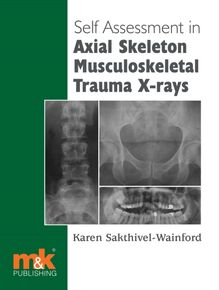-
 Univers
Univers
-
 Ebooks
Ebooks
-
 Livres audio
Livres audio
-
 Presse
Presse
-
 Podcasts
Podcasts
-
 BD
BD
-
 Documents
Documents
-
- Cours
- Révisions
- Ressources pédagogiques
- Sciences de l’éducation
- Manuels scolaires
- Langues
- Travaux de classe
- Annales de BEP
- Etudes supérieures
- Maternelle et primaire
- Fiches de lecture
- Orientation scolaire
- Méthodologie
- Corrigés de devoir
- Annales d’examens et concours
- Annales du bac
- Annales du brevet
- Rapports de stage
La lecture à portée de main
Vous pourrez modifier la taille du texte de cet ouvrage
Découvre YouScribe en t'inscrivant gratuitement
Je m'inscrisSelf-assessment in Limb X-ray Interpretation , livre ebook
Découvre YouScribe en t'inscrivant gratuitement
Je m'inscrisEn savoir plus
Vous pourrez modifier la taille du texte de cet ouvrage
En savoir plus

Description
Sujets
Informations
| Publié par | M&K Publishing |
| Date de parution | 04 décembre 2006 |
| Nombre de lectures | 0 |
| EAN13 | 9781907830136 |
| Langue | English |
Informations légales : prix de location à la page 0,0960€. Cette information est donnée uniquement à titre indicatif conformément à la législation en vigueur.
Extrait
Self-assessment in Limb X-ray Interpretation
Forthcoming titles from M&K Publishing
Improving Patient Outcomes: A Guide for Ward Managers
ISBN 978-1-905539-06-1
Modern Management in Chronic Disease and Long-Term Conditions
ISBN 978-1-905539-15-4
The ECG Workbook
ISBN 978-1-905539-14-7
Nurse-Facilitated Hospital Discharge
ISBN 978-1-905539-12-6
The Advanced Respiratory Practitioner: A Practical and Theoretical Guide for Nurses and AHPs
ISBN 978-1-905539-10-9
Pre-Operative Assessment and Perioperative Management
ISBN 978-1-905539-02-9
Pre-Teen and Teenage Pregnancy: A 21st-Century Reality
ISBN 978-1-905539-11-8
Eye Emergencies: The Practitioner s Guide
ISBN 978-1-905539-08-6
Managing Emotions in Women s Health
ISBN 978-1-905539-07-X
Ionising Radiation (Medical Exposure) Regulations – Theory Training Module
ISBN 978-1-905539-04-8
Ward-based Critically Ill Patients: A Guide for Health Professionals
ISBN 978-1-905539-03-1
The Management of Pain in Older People
ISBN 978-1-905539-22-2
Prescribing for Advanced Medical Practitioners Working in Musculoskeletal Medicine
ISBN 978-1-905539-09-3
Self-assessment in
Limb X-ray Interpretation
Musculoskeletal Trauma Imaging of Appendicular Skeleton
Karen Sakthivel-Wainford
M&K Publishing ©2006 M&K Update Ltd
First published 2006
All rights reserved. No part of this publication may be reproduced, stored in a retrieval system, or transmitted in any form or by any means, electronic, mechanical, photocopying, recording or otherwise, without either the prior permission of the publishers or a licence permitting restricted copying in the United Kingdom issued by the Copyright Licensing Agency, 90 Tottenham Court Road, London, W1T 4LP. Permissions may be sought directly from M&K Publishing, phone: 01768 773030, fax: 01768 781099 or email: publishing@mkupdate.co.uk
Any person who does any unauthorised act in relation to this publication may be liable to criminal prosecution and civil claims for damages.
Notice: Clinical practice and medical knowledge constantly evolve. Standard safety precautions must be followed, but as knowledge is broadened by research, changes in practice, treatment and drug therapy may become necessary or appropriate. Readers must check the most current product information provided by the manufacturer of each drug to be administered and verify the dosages and correct administration, as well as contraindications. It is the responsibility of the practitioner, utilising the experience and knowledge of the patient, to determine dosages and the best treatment for each individual patient. Neither the publisher nor the authors assume any liability for any injury and/or damage to persons or property arising from this publication.
The Publisher
To contact M&K Publishing write to: M&K Update Ltd The Old Bakery St John s Street Keswick Cumbria CA12 5AS a part of M&K Update Ltd
Tel: 01768 773030 Fax: 01768 781099 publishing@mkupdate.co.uk www.mkupdate.co.uk
British Library Catalogue in Publication Data A catalogue record for this book is available from the British Library
ISBN: 978-1-905539-13-0
Designed and illustrated by Mary Blood Typeset in 11pt Usherwood Book Printed in United Kingdom Printed by Reed s Ltd, Penrith
Contents
Acknowledgements
1. Introduction
2. Medico-legal aspects of radiographer reporting
3. Simple guidelines on reviewing trauma radiographs
4. Foot and ankle trauma
5. Knee, tibia and fibula trauma
6. Hand and wrist trauma
7. Elbow and forearm trauma
8. Shoulder trauma
9. A selection of cases
Bibliography/Reading list
Index
Acknowledgements
Firstly, to a musculoskeletal consultant radiologist (Wayne Gibbons), who worked in our Trust a long while ago, and the then radiographer manager who believed we radiographers, with training, could report trauma radiographs and started several of us on this path.
For the continued support of the X-ray staff at the Leeds General Infirmary, and Wharfedale General Hospital, and kind permission to use the radiographs.
For the help and support of my husband, Sakthivel, especially with the computer work.
Last but not least, thanks to Gary Culpin for taking the time to provide an excellent chapter for this book. Also to my colleague, Paul Atkinson, for use of some of his collection of radiographs and ideas for the guidelines in Chapter 2 .
Introduction
The number of professions that review and formulate a written report/opinion on trauma radiographs has increased over the last ten years to include nurse practitioners, radiographers and radiographer practitioners. Radiographer practitioners post-training formulate first and second (final) reports, depending on training and which Trust they work in. For many years radiographers have been ‘red dotting’ casualty radiographs, although now with increased knowledge obtained from the many ‘red dot’ courses available. In our Trust, some radiographers also, following in-house training, assessment and audit, write comments on appendicular trauma radiographs. Radiographers commenting on casualty radiographs instead of ‘red dotting’ is starting to happen in other Trusts. Nurse practitioners, in order to provide a complete service to their casualty patient, are also commenting on trauma radiographs (in our Trust following the same training and assessment radiographers undertake).
This book is written for all of you – ‘red dotting’ radiographers, commenting radiographers, radiographer practitioners, nurse practitioners – unlike most musculoskeletal trauma books which are written primarily with doctors in mind (although junior doctors working in casualty may find this book useful).
This book is intended to be like sitting in on a reporting session with a radiologist or radiographer practitioner, where you are asked to report/comment on the radiograph, but also asked some questions and given feedback. It is intended to support whatever course you have done, whether it be reporting, ‘red dotting’ or commenting, or to encourage you to go on ‘that course’. It can be used as a revision book, or to help in preparation for an assessment. However you use it, I hope it will encourage you to read more, and research more into musculoskeletal trauma and its radiographic appearance; for it is a fascinating topic and there is always more to learn!
The book starts with a chapter by Gary Culpin, a reporting radiographer since 1995, with several published articles to his name. Nowadays he is a senior lecturer at Bradford University, running their well-established reporting course. I, with my colleagues, was on that first reporting course at Bradford University a long time ago (1996). Gary writes on the legalities surrounding reporting on trauma radiographs. This is followed by some simple guidelines on reviewing radiographs.
We then present a series of trauma cases of the appendicular skeleton on which you are asked to write reports, plus sometimes a few other questions. This section is divided into six chapters: trauma radiographs of the foot and ankle; the knee, tibia and fibula; the wrist and hand; the elbow and forearm; the shoulder (15 cases in each chapter); and the last chapter which includes 25 cases of mixed appendicular trauma. Although it is probably best to work your way through the book from the beginning, if you need a little revision on, for example knee trauma, you can turn to Chapter 4 , then turn to the mixed appendicular trauma chapter to test yourself again. All the cases have been anonymised (hence often have no anatomical markers). Although all the cases have some clinical history that is appropriate to their injury, these are not necessarily the original clinical histories, in order to ensure that they remain anonymous. The answers are provided immediately after each case, with additional information where necessary. I am not going to tell you whether the cases are all abnormal; that is for you to decide.
Lastly, there is a list of texts and articles I have found particularly useful in my continued learning. There are, however, many other texts which you may find equally useful. The internet is also a useful source of information for reporting radiographs, though I have not included any websites as they change so frequently.
Different disciplines in different Trusts report on radiographs at different levels. For example, some radiographer practitioners report on all musculoskeletal trauma, some only on appendicular trauma, others are not allowed to report on paediatric trauma. Hence this book is one in a series in order to accommodate all levels of radiograph reporter. The reader may therefore choose the book or books that are most appropriate to their own requirements.
1.
Medico-legal aspects of radiographer reporting
Gary Culpan (DCRR, PGCHSM, PGCHEP, MSc, Lecturer in Radiography, Course leader for Post Graduate Diploma in Radiographic Image Interpretation, University of Bradford)
Introduction
Radiographer role expansion is not a new phenomenon. There have been a range of changes over many years, but the issue of radiographer reporting is one which seems to polarise opinion either for or against. With this particular encroachment on the traditional territory of the clinical radiologist comes a series of issues which need to be considered if the practice is to be undertaken safely and within current clinical and medico-legal practice guidelines.
The main influencing bodies for the medico-legal aspects of radiographer role extension, especially within the area of medical image reporting, include the College of Radiographers (CoR) as the professional body for radiographers, and the Society of Radiographers (SoR), as well as the radiographers’ trade union, the Health Professions Council (HPC) as the regulatory and registration body, the Royal College of Radiologists (RCR) as the professional body for clinical radiologists, and the General Medical Council (GMC) as the regulatory body for doc
-
 Univers
Univers
-
 Ebooks
Ebooks
-
 Livres audio
Livres audio
-
 Presse
Presse
-
 Podcasts
Podcasts
-
 BD
BD
-
 Documents
Documents
-
Jeunesse
-
Littérature
-
Ressources professionnelles
-
Santé et bien-être
-
Savoirs
-
Education
-
Loisirs et hobbies
-
Art, musique et cinéma
-
Actualité et débat de société
-
Jeunesse
-
Littérature
-
Ressources professionnelles
-
Santé et bien-être
-
Savoirs
-
Education
-
Loisirs et hobbies
-
Art, musique et cinéma
-
Actualité et débat de société
-
Actualités
-
Lifestyle
-
Presse jeunesse
-
Presse professionnelle
-
Pratique
-
Presse sportive
-
Presse internationale
-
Culture & Médias
-
Action et Aventures
-
Science-fiction et Fantasy
-
Société
-
Jeunesse
-
Littérature
-
Ressources professionnelles
-
Santé et bien-être
-
Savoirs
-
Education
-
Loisirs et hobbies
-
Art, musique et cinéma
-
Actualité et débat de société
- Cours
- Révisions
- Ressources pédagogiques
- Sciences de l’éducation
- Manuels scolaires
- Langues
- Travaux de classe
- Annales de BEP
- Etudes supérieures
- Maternelle et primaire
- Fiches de lecture
- Orientation scolaire
- Méthodologie
- Corrigés de devoir
- Annales d’examens et concours
- Annales du bac
- Annales du brevet
- Rapports de stage








